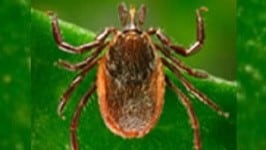Key points
- Outdoor workers are at risk of exposure to tickborne diseases.
- Worksites with woods, bushes, high grass, or leaf litter are likely to have more ticks.
- Employers can protect their workers and workers can protect themselves from ticks.

Overview
Ticks can be infected with bacteria, viruses, or parasites. Bites from infected ticks can pass tickborne pathogens to humans.
CDC has information related to ticks and tickborne disease, including:
- Diseases transmitted by ticks
- Symptoms of tickborne diseases
- What to do if a tick bites you
- The geographic distribution of ticks
Worksites with woods, bushes, high grass, or leaf litter are likely to have ticks. Ticks may be active all year in some regions with warmer weather. In the United States, they are most active in the spring, summer, and fall.
Who is at risk
Outdoor workers are at risk of exposure to tickborne diseases if they work at sites with ticks. All outdoor workers should check with their supervisor if they have questions about tick exposure. Workers at risk of tickborne diseases include, but are not limited to, those working in:
- Construction
- Landscaping
- Forestry
- Land surveying
- Farming
- Railroad work
- Oil field work
- Utility line work
- Park or wildlife management
Prevention
Recommendations for employers
Provide training for workers that includes information about:
- How tickborne diseases spread.
- Risks of exposure and infection.
- How workers can protect themselves from ticks.
- Reporting workplace illnesses and injuries.
Tell workers to wear light-colored long-sleeved shirts, pants, socks, and hat when possible. If uniforms are provided, have long-sleeved shirts and pants as options.
Provide workers with Environmental Protection Agency (EPA)-registered insect repellents containing one of the following:
- DEET
- Picaridin
- IR3535
- Oil of Lemon Eucalyptus (OLE)
- Para-menthane-diol (PMD)
- 2-undecanone
Provide workers with repellents (such as Permethrin) to provide greater protection. Permethrin kills ticks on contact. It can be used on clothing but not skin.
When possible, have workers avoid working at sites with woods, bushes, tall grass, and leaf litter. When avoiding these sites is not possible:
- Remove leaf litter.
- Remove, mow, or cut back tall grass and brush.
- Discourage deer activity.
Recommendations for workers
Wear a hat and light-colored clothing, including long-sleeved shirts and long pants tucked into boots or socks.
Use an Environmental Protection Agency (EPA)-registered insect repellant. EPA’s search tool can help you find the product that best suits your needs. Always follow product instructions.
Treat clothing and gear with products containing 0.5% permethrin. Permethrin kills ticks on contact. It should not be used on skin.
Check your skin and clothes for ticks every day.
- Shower or bathe as soon as possible to wash off and check for ticks.
- Remember to check your hair, underarms, and groin for ticks.
Immediately remove ticks from your body using fine-tipped tweezers.
- Grasp the tick firmly and as close to your skin as possible.
- Pull the tick's body away from your skin with a steady motion.
- Clean the area with soap and water.
Wash and dry work clothes in a hot dryer to kill any ticks present.
Learn the symptoms of tickborne diseases.
If you develop symptoms of a tickborne disease, seek medical attention. Tell your health care provider that you work outdoors in an area where ticks may be present.
